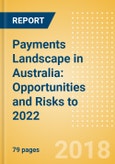Payments Landscape in Australia: Opportunities and Risks to 2022
Summary
The Author's "Payments Landscape in Australia: Opportunities and Risks to 2022", report provides detailed analysis of market trends in the Australian cards and payments industry. It provides values and volumes for a number of key performance indicators in the industry, including cards, cash, direct debit, credit transfers, and cheques during the review-period (2014-18e).
The report also analyzes various payment card markets operating in the industry and provides detailed information on the number of cards in circulation, transaction values and volumes during the review-period and over the forecast-period (2018e-22f). It also offers information on the country's competitive landscape, including market shares of issuers and schemes.
The report brings together the Author’s research, modeling, and analysis expertise to allow banks and card issuers to identify segment dynamics and competitive advantages. The report also covers detailed regulatory policies and recent changes in regulatory structure.
This report provides top-level market analysis, information and insights into the Australian cards and payments industry, including -
Scope
Reasons to buy
Summary
The Author's "Payments Landscape in Australia: Opportunities and Risks to 2022", report provides detailed analysis of market trends in the Australian cards and payments industry. It provides values and volumes for a number of key performance indicators in the industry, including cards, cash, direct debit, credit transfers, and cheques during the review-period (2014-18e).
The report also analyzes various payment card markets operating in the industry and provides detailed information on the number of cards in circulation, transaction values and volumes during the review-period and over the forecast-period (2018e-22f). It also offers information on the country's competitive landscape, including market shares of issuers and schemes.
The report brings together the Author’s research, modeling, and analysis expertise to allow banks and card issuers to identify segment dynamics and competitive advantages. The report also covers detailed regulatory policies and recent changes in regulatory structure.
This report provides top-level market analysis, information and insights into the Australian cards and payments industry, including -
- Current and forecast values for each market in the Australian cards and payments industry, including debit, credit, and charge cards.
- Detailed insights into payment instruments including cards, cash, direct debit, credit transfers, and cheques. It also, includes an overview of the country's key alternative payment instruments.
- E-commerce market analysis and payment methods.
- Analysis of various market drivers and regulations governing the Australian cards and payments industry.
- Detailed analysis of strategies adopted by banks and other institutions to market debit, credit, and charge cards.
Scope
- To offer enhanced convenience and encourage electronic payments for even low-value transactions, in February 2018 the Reserve Bank of Australia (RBA) and its Payments System Board rolled out a new payments infrastructure known as the New Payments Platform (NPP) that allows customers with accounts with different banks to make payments and transfer funds in real-time. It is available 24/7, 365 days a year. Developed by SWIFT in collaboration between 13 members of Australia’s financial services industry, the platform provides an addressing service known as PayID, which allows users to enter only the recipients mobile phone number or email address to transfer the money.
- The advent of digital-only banks is likely to stir competition in the Australian banking sector over the coming years. Volt Bank received a Restricted ADI (RADI) license from the Australian Prudential Regulation Authority (APRA) in May 2018, enabling it to offer a limited number of products and services, before a full banking license is given. Fintech startup Xinja is also seeking a full banking license and hopes to break into mainstream banking. Other challenger banks named ‘86 400’ and ‘Up’ are to be launched soon.
- Growth in the Australian credit card market is likely to slow in the coming years in the wake of several regulatory overhauls by the government. In February 2018 the Australian parliament passed a new bill that aims to crack down on credit card providers’ unfair practices. As a result, from July 2018 financial services providers are required to analyze the affordability of a credit card based on a consumer’s capability to repay the limit within a reasonable duration. The bill also calls for additional reforms from January 2019, including a ban on unsolicited invitations from banks to increase credit limits, and simplified interest calculation. In addition, banks will be mandated to offer the option to cancel a card or reduce the credit limit online. Previously, the Australian Competition and Consumer Commission (ACCC) banned all businesses, including large and small merchants, from collecting excessive surcharges on credit and debit card payments. The new rule, which is effective from September 1, 2017, is applicable to all businesses based in Australia or that use an Australian bank.
Reasons to buy
- Make strategic business decisions, using top-level historic and forecast market data, related to the Australian cards and payments industry and each market within it.
- Understand the key market trends and growth opportunities in the Australian cards and payments industry.
- Assess the competitive dynamics in the Australian cards and payments industry.
- Gain insights into marketing strategies used for various card types in Australia.
- Gain insights into key regulations governing the Australian cards and payments industry.
Table of Contents
Table of ContentsMarket Overview
EXECUTIVE SUMMARY
Card-based Payments
Merchant Acquiring
E-commerce Payments
Mobile Proximity Payments
P2P Payments
Alternative Payments
Payment Innovations
Payments Infrastructure & Regulation
Appendix
Companies Mentioned (Partial List)
A selection of companies mentioned in this report includes, but is not limited to:
- Commonwealth Bank
- Westpac
- ANZ Bank
- National Australia Bank
- Bendigo and Adelaide Bank
- Citibank
- Tyro
- eftpos
- Visa
- Mastercard
- American Express
- Diners Club








